|
We are rather apt to take for granted the exceptional performance of a modern receiver. If we pause awhile and consider the sets of two or three years ago, and compare the results, we are constrained to ask which is the single factor that has contributed most to the vast improvement. There is not the slightest doubt that we must turn for the answer to the thermionic valve, which has been developed at a prodigious rate. No slackening of effort has taken place this season, for a number of new valves make their appearance, and much improvement has been made to the types already existing. The large scale models of electrode construction which were shown on the leading manufacturers stands (Radiolympia 1932) bear witness to the efforts that have been made to ensure absolute rigidity and hence absence of microphony.
The Screen-grid Valve Superseded
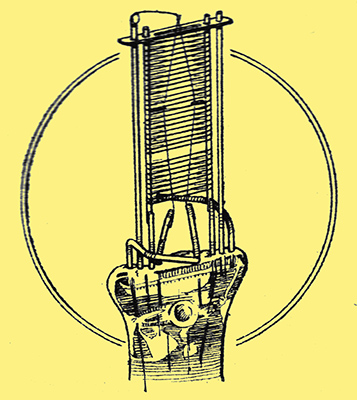
Constructional details of the Osram VS2, a battery variable-μ type.
The ordinary screen-grid valve which a comparatively short time ago was hailed as a panacea for all high-frequency troubles seems to be disappearing in favour of the variable-mu type, which has played a large part in making possible the modern superheterodyne. The use of this type of valve is not confined to AC mains sets, as was the case last year, for there are a number of both battery and DC mains models now available.
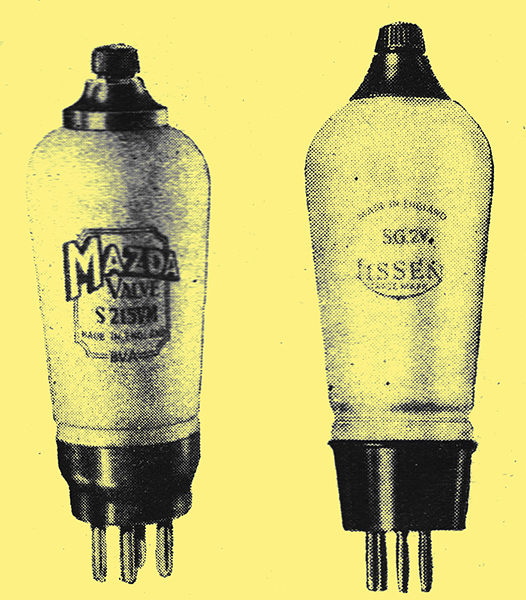
Mazda 2 Volt battery variable-μ, the S215VM, and (right) the Lissen 2 Volt battery type the SG2V.
For two Volt battery sets there is the Cossor 220VSG, the Marconi and Osram VS2, the Mazda S215VM, the Mullard PM12V, and the Lissen SG2V, all of which have a mutual conductance between 1 and 2 mA/Volt and are capable of giving a full-range control of volume making use of the bias battery for the output stage.
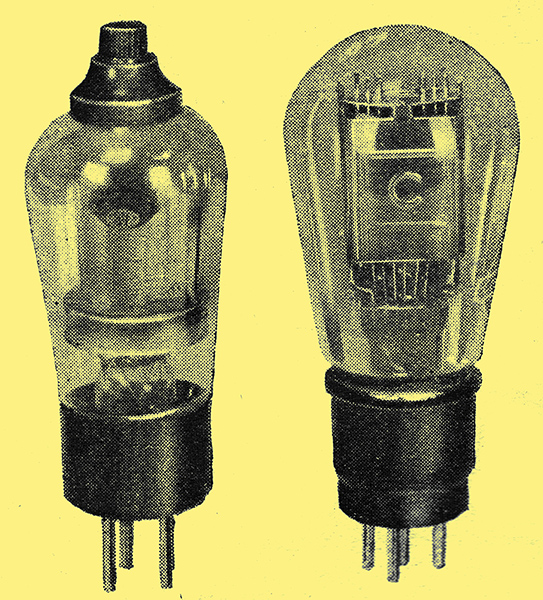
The Six-Sixty battery type screen-grid valve and the Cossor directly heated Pentode.
DC Mains Valves At Last! There has been definite progress with valves for DC mains. Those having this type of supply need no longer fear that they will have to foot a heavy bill at the end of the quarter, as the consumption of a set will not exceed about 60 Watts at the most, or with the latest 0.1 Amp series, some 20 Watts. In addition, the DC set designer has at his command valves for the HF amplifier, power detector, and small output stage which are in no way inferior to their AC counterparts. When the indirectly heated DC valves were first embarked upon it was found that the heater-cathode insulation was liable to break down under the influence of high voltages developed in a multi-valve set. Continual research has produced a DC valve in which the heater-cathode insulation is unaffected by a difference of potential of considerably over 100 Volts. The number of Marconi, Osram, and Mazda DC mains valves now totals 15, so that a wide choice is available. Interesting newcomers in this class are the Marconi and Osram VDS and the Mazda DC/2SGVM, both of which are variable-mu valves, the former having a heater consumption of 0.25 Amp at 16 Volts and the latter 0.1 Amp at 20 Volts.
Although the use of the screen-grid valve as a detector is not new, up to the present it has only been employed in isolated cases. There are to be found this season a number of sets with this feature embodied, notably on the GEC stand. The advantages are considerable, for not only does the SG valve give a larger output than the triode for a given input, but the input capacity, which is extremely small, remains constant throughout the Waveband. With the triode the input capacity is large, and changes according to the frequency being received, thus demanding a change of trimming capacity if ganged capacitors are used. The value of the anode load using a paralleled transformer is somewhat critical and should not exceed 40,000 Ω in the case, for instance, of the Marconi and Osram MS4B.
Special Detectors
Among other special detectors reference must be made to the Mullard 904V and the Standard Telephones and Cables Micromesh HLA1, in which attention has been given to the anode-to-grid capacity to minimise Miller effect. There is no counterpart yet to the American Wunderlich valve, which permits many circuit innovations, including push-pull detection, but a duo-diode, as it is called, was to be found in certain superheterodynes at the Show. This valve, which is an ordinary Mazda indirectly heated full wave mains rectifier, type UU2, is fed from the IF stage and forms part of a push-pull circuit. By virtue of wide spacing of the two anodes, the inter-electrode capacity is low.
Valves in New Receivers
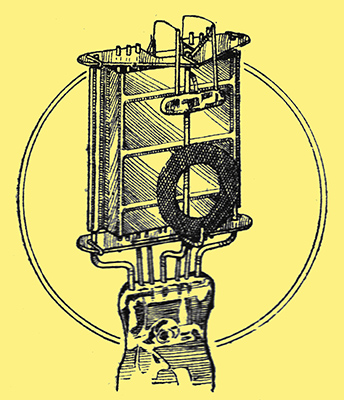
Drawing of the electrodes of the new Osram PT4 with directly heated filament (4 V 1 Amp).
A number of receivers being exhibited were found to contain an aperiodic HF stage (screen-grid). Actually it would be better to call them semi-aperiodic, as they are arranged to peak at the upper end of both wavebands to compensate for the natural drop in dynamic resistance of sharply tuned circuits at these wavelengths. The demand for high-quality reproduction at a realistic volume level has influenced the valve makers to produce a number of new and highly efficient output valves. The directly heated pentode capable of handling powerful signals bids fair to rival the power triode for the reason that it is now possible with such valves as the Marconi and Osram PT25 to extract as much as 40% of the DC anode dissipation as AC energy. With the three-electrode valve the relationship seldom exceeds 20%. Other new directly heated pentodes are the Cossor PT41B and the Mullard PM24M.
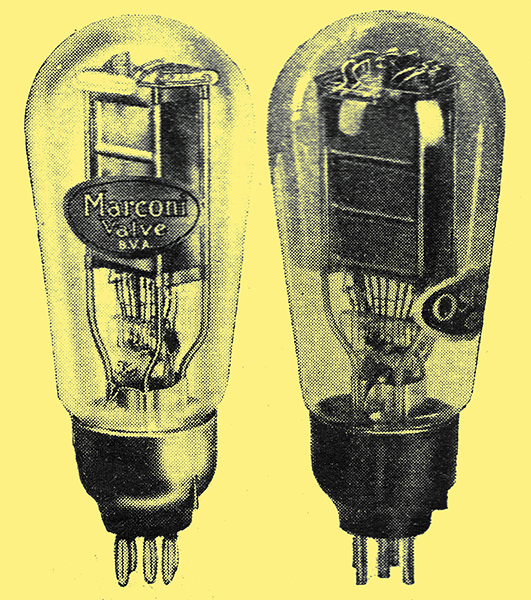
Marconi output valve the PX25 and the Osram directly heated Pentode type PT25.
To the large range of output valves has been added the Mazda PP3/250, the Marconi and Osram PX25 and a modified PX4 - all triodes. A power valve which sets a new standard of efficiency is the Standard Micromesh PA1, with a mutual conductance exceeding 12 mA/Volt; this is almost double that of any other valve on the market.
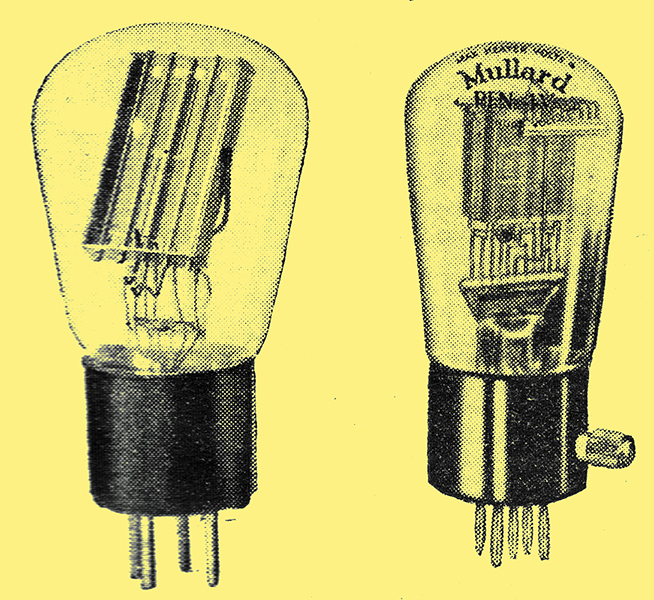
The remarkable Micromesh power valve PA1. On the right is the Mullard Pentode type Pen4V.
|